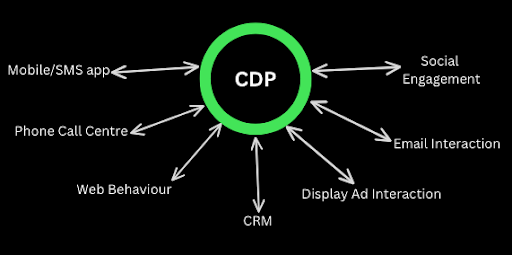Customer Data Platform
Definition
A customer data platform (CDP) is a software platform designed to collect, unify, and manage customer data from multiple sources in a centralised location.
Description
Personalising customer experience is important for businesses to beat the competition.
A CDP enables companies to comprehensively view their customer’s behaviour, preferences, and interactions across various channels, such as websites, mobile apps, social media, email, and offline touchpoints.

CDPs use various data sources, such as customer relationship management (CRM) systems, marketing automation tools, e-commerce platforms, social media platforms, and third-party data providers, to create a unified customer profile.
The profile includes customer demographic information, browsing history, purchase behaviour, and other relevant data points.
Importance of CDP
Customer data is essential for businesses to understand customers’ needs, preferences, and behaviour.
With a centralised platform to collect and manage customer data, companies understand their customers comprehensively, resulting in missed opportunities for personalised experiences and improved customer engagement.
Here are some of the key reasons why a CDP is important for businesses:
- Consolidates customer data: A CDP consolidates customer data from various sources into a centralised location. This enables businesses to comprehensively view their customers and their interactions across multiple channels.
- Provides a unified customer profile: A CDP creates a unified customer profile that includes data on customer demographics, behaviour, preferences, and interactions. This provides a holistic view of the customer and enables businesses to deliver personalised experiences and targeted marketing campaigns.
- Improves customer engagement: By using the insights gained from a CDP, businesses can better understand their customers and deliver personalised experiences that resonate with them. This can lead to increased engagement, loyalty, and retention.
- Enables data-driven decision-making: A CDP provides insights into customer behaviour and preferences, which can be used to inform business decisions, product development, and marketing strategies. This enables businesses to make data-driven decisions based on a deep understanding of their customers.
- Increases operational efficiency: By consolidating customer data into a single platform, a CDP can improve operational efficiency by reducing the time and resources needed to manage customer data across multiple systems.
How do Customer Data Platform (CDP) collect data?
CDPs typically use a variety of methods to collect and ingest data, including:
- API connections: CDPs can use application programming interfaces (APIs) to connect to other systems and collect data automatically. For example, a CDP can use APIs to collect data from a company’s CRM, marketing automation platform, or e-commerce platform.
- Batch uploads: Companies can upload data files to a CDP regularly. This can include customer lists, transactional data, or other data types.
- Tagging and tracking: CDPs can use tags or tracking codes to collect data from a company’s website or mobile app. This can include data on customer behaviour, such as page views, clicks, or conversions.
- Data connectors: CDPs can use pre-built data connectors to external data sources, such as social media platforms, advertising networks, or data brokers.
What are the sources from which Customer Data Platform collects data?
- First-party data: This is data that a company collects directly from its customers. For example, a CDP can collect customer data from a company’s website, mobile app, point-of-sale system, or customer service interactions.
- Second-party data: This is data that a company obtains from another organisation that has collected the data directly from its customers. For example, a company may purchase data from a partner that has collected data on a specific demographic or audience.
- Third-party data: This is data that a company obtains from external data providers, such as data brokers. Third-party data can include demographic, behavioural, and transactional data.
Future changes expected in Customer Data Platform (CDP)
Customer Data Platforms (CDPs) are constantly evolving to meet the changing needs of businesses and customers. Here are some of the future changes that we can expect in CDP:
- Enhanced AI and machine learning capabilities: CDPs will continue to improve their AI and machine learning capabilities to help businesses gain deeper insights into their customers. This will enable more personalised experiences and more effective targeting of marketing campaigns.
- Greater focus on privacy and data protection: With increased concerns over data privacy and security, CDPs will need to emphasise privacy and data protection more. This may include stronger encryption, more robust access controls, and other measures to protect customer data.
- Integration with emerging technologies: CDPs must integrate with emerging technologies, such as voice assistants, chatbots, and augmented reality, to provide seamless customer experiences across multiple channels.
- Real-time data processing: CDPs must improve their real-time data processing capabilities to provide businesses with up-to-the-minute insights into customer behaviour and preferences. This will enable businesses to respond quickly to changing customer needs and preferences.
- Greater emphasis on data quality: As the volume of customer data grows, CDPs will need to emphasise data quality more. This may include automated data validation, cleaning, and other measures to ensure data accuracy and reliability.
Benefits of Customer Data Platform
A Customer Data Platform (CDP) is a software system that collects, unifies and manages customer data from various sources, such as CRM systems, website interactions, social media, email marketing, and more.
CDPs help businesses comprehensively understand their customers and leverage that knowledge to improve their marketing, customer service, and overall customer experience. Here are some of the benefits of a CDP:
- Unified customer data: CDPs consolidate customer data from multiple sources, providing a unified view of customer behaviour and preferences. This enables businesses to understand customer interactions across channels and touchpoints.
- Enhanced customer experiences: With a better understanding of customer behaviour and preferences, businesses can personalise their marketing and customer service efforts, creating a more engaging and relevant customer experience.
- Improved marketing effectiveness: CDPs can help businesses optimise their marketing campaigns by providing insights into which channels and messages are most effective for customer segments.
- Better customer segmentation: CDPs can help businesses segment their customers based on various criteria, such as demographics, behaviour, and preferences. This enables businesses to create targeted marketing campaigns and personalised experiences for each segment.
- Data privacy compliance: CDPs help businesses comply with data privacy regulations by providing a centralised platform to manage customer data and ensure data security.
Example
Flipkart, India’s largest e-commerce company, uses a CDP to collect and manage customer data across multiple channels.
The CDP enables Flipkart to create a unified customer profile that includes data on customer demographics, behaviour, preferences, and interactions.
This allows Flipkart to deliver personalised experiences and targeted marketing campaigns that drive engagement and loyalty.

Flipkart’s CDP collects data from multiple sources, including customer transactions, website interactions, and mobile app usage.
The CDP uses machine learning and other techniques to process and unify the data, providing Flipkart with a holistic view of its customers.
Using the insights gained from its CDP, Flipkart can offer personalised product recommendations, targeted promotions, and other features that improve the customer experience.
This has helped Flipkart to maintain its position as India’s leading e-commerce company and drive continued growth in the highly competitive Indian market.
FAQ
What is a Customer Data Platform (CDP)?
A Customer Data Platform is a software platform that allows businesses to collect and manage customer data from multiple sources and create a comprehensive customer profile that can be used to personalise the customer experience.
What are the benefits of using a CDP?
Some benefits of using a CDP include: gaining a comprehensive understanding of customers, creating personalised experiences, improving customer engagement and loyalty, and driving revenue growth.
What types of data can a CDP collect?
A CDP can collect a wide range of data types, including demographic data, transactional data, website and mobile app usage data, social media data, and more.
How does a CDP differ from other customer data management tools?
A CDP is specifically designed to collect and unify customer data from multiple sources and create a comprehensive customer profile. Other customer data management tools, such as CRMs or marketing automation platforms, may focus on specific aspects of customer data management.
Is a CDP only useful for large businesses?
No, businesses of all sizes can benefit from using a CDP. Small and medium-sized businesses can use a CDP to better understand their customers and deliver personalised experiences, just like larger businesses.
How does a CDP ensure data privacy and security?
A CDP can ensure data privacy and security by implementing encryption, access controls, and other security protocols. Additionally, many CDPs are compliant with data privacy regulations, such as GDPR and CCPA.
How much does a CDP cost?
The cost of a CDP can vary depending on the specific platform and the business size. Some CDPs offer tiered pricing based on the number of contacts or data volume, while others offer custom pricing based on the business’s specific needs.
How can businesses integrate a CDP into their existing systems?
CDPs typically offer integrations with a wide range of marketing automation, CRM, and other systems. Depending on the specific CDP and integrated systems, integration can be done through APIs, batch uploads, or other methods.





We would love to have your opinion.